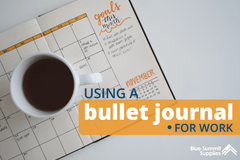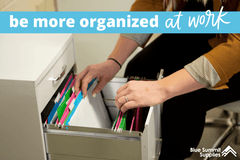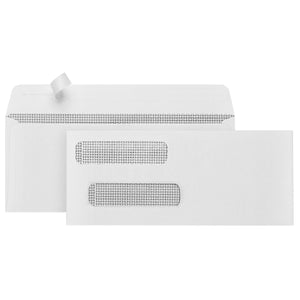If you’re like many Americans, you might get your daily workout done in the morning before work. Whether it’s how you wake up, get motivated for the day ahead, or exercise your stress, working out is beneficial. But after your run, yoga, or strength training, most of us wind up at a desk (or in the age of more remote work, maybe even at a kitchen table, counter, or the couch). This is far from ideal – we need to be active all day, and that includes doing our best to stay active at work.
The CDC recommends 150 minutes of moderate-intensity aerobic physical activity or 75 minutes of vigorous-intensity physical activity per week, but further research has suggested that it’s not enough to have a morning workout or list of exercises to do every day. Studies have found that the minimum suggested level of activity might not counteract the harmful effects of prolonged sitting.
Finding small ways to stay active at work can make a big difference in your health and well-being.

The Risks of Being Sedentary at Work
Most Americans – between commuting, desk work, and downtime – can spend an average of between 11 and 13 hours seated every day. According to the organization Just Stand, “the term ‘Sitting Disease’ has been coined by the scientific community and is commonly used when referring to metabolic syndrome and the ill-effects of an overly sedentary lifestyle.” While it isn’t a diagnosable disease, the health risks for this phenomenon are real.
According to John Hopkins University, physical inactivity can lead to any of the following:
- Increased risk of certain cancers
- Anxiety and depression
- Increased risk of cardiovascular diseases
- Weight problems
- Joint pain
- Decreased skeletal muscle mass
- High blood pressure and elevated cholesterol levels
To combat these risks, it’s important that exercise, movement, and physical activity don’t stop once you reach your desk.
The Benefits of Staying Active at Work
More movement matters. Even small changes done consistently can help you reap these benefits.
Here are a few benefits to getting active at your desk.
Reduce risk for disease
Lower levels of fitness are linked to the increased risk of illnesses like type 2 diabetes, cancer, heart attack, and stroke. Fitness doesn’t have to just be a morning run or gym session after work; finding ways to move more and sit less during the day can go a long way in helping you reach your health goals.
Boost your metabolism
Alternating between sitting and standing during the day can help you burn more calories and keep your metabolism from slowing down as the day goes on. People can use up to 50 more calories per hour when they’re standing versus when sitting.
Reduce back pain
Sitting at a desk all day takes a toll on your back. Compressing the spine can cause pain and discomfort, which can be distracting throughout the day and make regular exercise more challenging. Standing and walking throughout the day helps increase spine stability and mobility and reduces the risk of future injury.
Increase productivity
Sitting can make anyone restless and distracted. Rather than take a break to mindlessly scroll social media, it can be beneficial to your mental and physical health (and quality of work) to take a walking break, do some simple stretches, or change positions while working
Gain energy and improve focus
Workspace health studies have found that workers report being more energized and better able to focus when they spend more time standing instead of sitting during the day. Even small, incremental movements built into your day can give you a physical and mental boost.
Sleep better
More movement is linked to better sleep. Exercise is key to quality sleep, and sleep is necessary for everything from improved immunity to better memory. To perform – physically and mentally – at your best, you need good sleep, and pushing yourself towards greater physical performance can help you sleep. If you’re not getting your daily exercise in, finding ways to make your workstation more active can help you get better sleep. This in turn can improve your workday. Small changes can add up to meaningful improvements that build on themselves over time.
Decrease stress and anxiety
Now more than ever, life can feel chaotic and unpredictable. Taking the time and space to pay more attention to your body every day can help reduce the stress, depression, and anxiety that might creep in throughout the day. While longer workout sessions like running or yoga might be the best for general stress-busting, a short walk or even a standing work session can help you feel more focused and more refreshed, resetting your body and your brain a bit and turning down the hum of anxiety.
How to Stay Active at Work
There are plenty of ways to improve your daily routine to stay healthy. Here are some ideas to get you started.
Add in movement intervals
As many of us have transitioned to work from home and remote working situations, more people have started adding in lunch time walks or after dinner hikes with the family as ways to break up the day and get out of the house. Here are some other ways to be mindful about movement whether you’re back in the office or still working from home.
- Start a timer. It’s very easy to get into the zone doing research, taking calls, checking emails, and writing reports. Setting a timer for movement breaks can help make sure you get more steps in, take a break to stand, or just walk into the kitchen to refill your water bottle. FitBit wearables, Apple Watches, and other devices often have a reminder option built in and can gently vibrate or alert you to get in more steps or take a movement break.
- Talk and walk. As more people have started working from home, more business has been conducted by phone and online voice and meeting software than ever before. It’s easy to take those calls on the move. For any meetings that don’t require you to be actively in front of your laptop, plug in your headset to your phone and take a walk while listening. For meetings that require you to be near your computer, take a few laps around the kitchen and have your computer on the counter. For video meetings, you can still add some movement in by standing at a kitchen island instead of in a desk chair. For those of us in the office, we suggest standing or walking meetings. Whether you have your daily conference room team check-ins standing or you have your employee weekly one-on-ones by walking around the building, it’s easy to start a habit of movement without hindering routines and communication
Use your lunch break to move.
Lunch time can be a great way to fit in your daily workout or add extra movement every day. Whether you take a walk around your office building or roll out a yoga mat in your living room, your body will benefit from some lunchtime fitness.

Utilize active desks
You can easily maximize movement during your workday with a sit-stand desk. Using a standing desk can help you add more movement without drastically changing your routine. An adjustable-height desk is a great option for many people because it allows people to sit as needed and gradually add more standing time throughout the day. Some people really commit to the concept of an active desk and invest in a treadmill desk or under-desk stationary bikes, which are both an excellent way to improve fitness and stay healthy while still being able to work in front of a screen or stay in the office. Several workspace solution companies offer sit-to-stand desktop adjusters or under desk treadmills and bikes to use with the desk you already have rather than having to invest in a completely new workstation.

Want details on standing desks? We’ve got info. Learn about standing desks here.

Utilize active seating
Active seats include refer to things like large exercise balls or active stools with a dynamic range of movement. They’re meant to keep you a little off balance, engage your core, and allow more movement in your lower body. Even a static, backless stool can help you sit a little straighter and stay more aware of your spine. All active seating options can help increase core strength, stability, and posture. It’s okay to start slow when it comes to finding out which position works best for you! Try different things and find what works in terms of time, effort, and resources. The goal is not to do everything, but to start with something.
Whether you work at a desk in the office or have a home office in your kitchen, there are plenty of ways to stay active at work. Finding ways to move more on the job throughout the day can have significant and lasting benefits on the way you feel and the way you work. With more movement added to every day, you can get more done and feel better doing it.
Need more office culture info? Check out the rest of our blog! Or come find us on Twitter, Instagram, and Facebook. If you have any comments or questions, send us an email – Larry loves to hear from you!
 For more informative articles about office supplies, subscribe to our email newsletter!
For more informative articles about office supplies, subscribe to our email newsletter!
Never fear, you won't begin receiving daily sales emails that belong in a spam folder. Instead, we promise a fun weekly roundup of our latest blog posts and great finds from across the web. And if you lose interest, it's always easy to unsubscribe with a single click.









